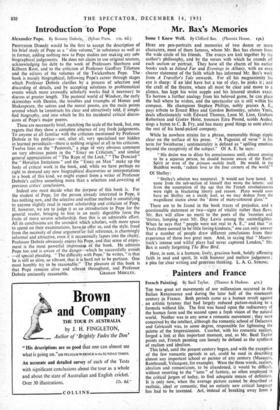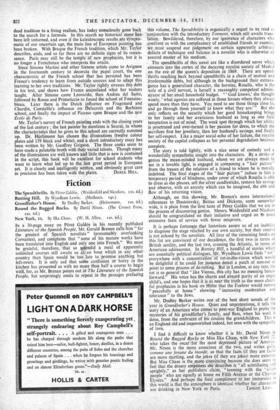. Painters and France
French Painting'. By Basil Taylor. (Thames & Hudson. 42s.) THE WO great art movements of our millennium occurred in the Italian Renaissance and during the later half of the nineteenth century France. Both periods came as a human revolt against an artistic tyranny that had largely reduced picture-making to a formula without life. The first was based upon the rediscovery of the human form and the second upon a fresh vision of the natural world.- Neither was in any sense a romantic movement ; they were conceived by the intellect, although the romantic -school of Delacroix and Gericault was, to some degree, responsible for lightening the palette of the Impressionists. Courbet, with his romantic realism, forged a link at this important moment, and, as Mr. Basil Taylor points out, French painting can loosely be defined as the synthesis of realism and idealism.
This label, until the present century began, and with the exception of the few romantic periods in art, could be used in describing almost any important "sehool or painter of any century (Masaccio, Rembrandt; Velazquez, for example). Were the three words, realism, idealism and romanticism, to be abandoned, it would be difficult, without resorting to the " isms " of fantasy, so often employed in the critical- jargon of today, to find adequate means of definition. It is only now, when the average picture cannot be. described as realistic, ideal or romantic, that an entirely new critical language has had to be invented. Art, instead of breaking away from a
dead tradition to a living realism; has today consciously gone back to the search for a formula. In this search no historical stone has been left unturned, and even if the kaleidoscopic results are sympto- matic of our uncertain age, the main line of European painting as been broken. With Braque the French tradition, which Mr; Taylor describes, ends, and so far there are no definite signs of its renais- sance. Paris may still be the temple of new prophecies, but it is no longer a Frenchman who interprets the oracle.
Since Simone Martini and other Sienese artists came to Avignon in the fourteenth century to decorate the papal court, the one characteristic of the French school that has persisted has been France's tendency to learn from outside sources -and to adapt this learning to her own traditions. Mr. Taylor rightly stresses this debt in his text, and shows how France assimilated what her visitors taught. After Simone came Leonardo, then Andrea 'del Sarto, followed by Rosso and Pritnaticcio to found the school of Fontaine- bleau. Later there is the Dutch influence on Fragonard and Chardin, Constable's influence on Delacroix and The' Barbizon school, and finally the impact of Picasso upon Braque_ and the new Ecole de Paris.
Mr. Taylor's-survey of French painting ends with the closing years of the last century the last painter be mentions is Seurat, in whom the characteristics that he gives to this school are correctly summed up. Dr. Htirlimann has chosen the illustrations (twelve colour plates mid 139 black and White), and a short introductory essay has been written, by Mr. Geoffrey Grigson. The three cooks seem to have made a palatable broth with their varied talents. Though many of the illustrations are well known and little.that is new is contained in the script, this bpok will be excellent for school students who want to learn what led up -to the _last great period in European art. It is clearly, and intelligently written, and ,obviously great care
in precision has been taken with the plates. DEREK HILL.







































 Previous page
Previous page